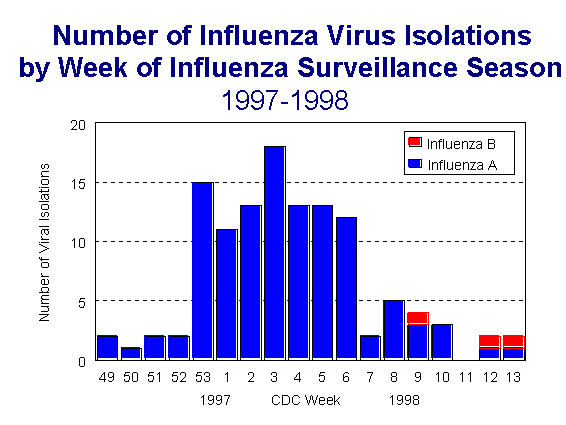
| Back to 1997 Indiana Report of Diseases |
Indiana Influenza Surveillance 1997-98
James F. Howell, DVM, MPH
Background:
Influenza surveillance during the 1997-98 influenza season was conducted in cooperation with the Centers for Disease Control and Prevention (CDC). ISDH participated in a pilot project with CDC and 30 other states to gather data on " influenza-like illness" morbidity and to identify influenza virus strains responsible for disease. Thirty physicians, nurse-managed clinics, and university health centers across the state volunteered to be sentinel sites. Their locations and number per county are identified in Figure 1.
Figure 1.

Methodology
During each week of the surveillance period, CDC week 9740 (ending Sat., Oct 4, 1997) to CDC week 9820 (ending Sat., May 23, 1998), each sentinel site tracked the number of patients requesting care for "influenza-like illness" by age groups. "Influenza-like illness" was defined as "Fever (> 100o F. [37.8o C], oral or equivalent) and cough or sore throat (in absence of a known cause)." Each week sentinel sites reported patient counts to CDC via telephone or facsimile. Participates were also asked to submit nasopharyngeal swabs from selected patients whose onset of clinical signs had started within 72 hours, to the Indiana State Department of Health Laboratory. The ISDH Laboratory identified virus isolations from patient specimens by influenza type and subtype using reagents provided by the CDC.
Outbreaks:
Outbreaks of influenza-like illness were reported from school districts in three counties during this year’s influenza season: Marion, Ripley, and Greene. Absentee rates varied from 15 to 29%. The school in Ripley County elected to close for two days in part because the illness among teachers made it logistically difficult to provide teachers for all classes. ISDH was able to obtain patient specimens from the Greene Co. students. Influenza A (H3N2) Sydney-like was isolated in three of five specimens from Greene Co. with illness onset dates between Jan 19 and Jan 26, 1998. The outbreak in the Marion Co. school was reported on January 16, the Friday before the three-day break for Martin Luther King’s Birthday.
Influenza-like illnesses in long-term care facilities was reported from facilities in Boone, Clinton, Dekalb, Jackson, Marshall, and Wabash counties.
Observations:
During the surveillance period, sentinel sites reported seeing 109,378 patients with 1867 seeking care for "influenza-like illnesses." The overall percentage of patients presenting with "influenza-like illness" was 1.71%. Based on previous experience, CDC has found that "influenza-like illness" rates between 0% and 3% it is more likely to be caused by respiratory viruses other than influenza, but when the percent of patients seeking care for "influenza-like illnesses" exceeds 3%, influenza is the predominant virus causing illness. Figure 2. provides a graphical display of the percent of patients seeking care for an "influenza-like illness" by week during the surveillance period. The percent of patients seeking care for "influenza-like illness" exceeded the 3% baseline for 6 of 7 weeks starting the 53rd week (week ending Jan 3). The percent of patients seeking care for "influenza-like illnesses" dropped below 3% the week of 98-07 (week ending Feb. 21) and remained below the baseline thereafter.
Figure 2.

The Indiana State Department of Health Virology Laboratory received 448 specimens for viral isolation and/or identification during the surveillance period. In addition to sentinel site submissions, specimens from hospitals and non-sentinel physicians were also submitted. One hundred ninety-two specimens (42.9%) yielded viral isolates. One hundred seventy-two (89.5%) of the isolates were identified as influenza A virus and 3 (1.58%) were identified as influenza B. Seventeen specimens (3.7%) yielded other viruses. The number of influenza virus positive throat/nasopharyngeal specimens increased seven fold the 53rd week of 1997, the same week that the percent of patients seeking care for influenza-like illnesses first exceeded 3%. Seventy-nine percent of the viral isolates for the influenza season were submitted during the seven weeks during which the percent of patients seeking care for influenza-like illness exceeded 3%. Figure 3. displays the number of influenza virus positive specimens by week of the patient’s disease onset. The trend of virus isolations follows closely that observed in Figure 2. indicating that the increased percentage of patients seeking care for "influenza-like illness" were most likely due to infection with influenza virus.
Figure 3.

All Influenza A isolates were characterized as (H3N2). Sub-typing accomplished early in the season indicated that A/Nanchang-like virus was circulating in Indiana. Additional reagents needed to separate A/Sydney from A/Nanchang were not received from CDC until Feb 1998. Influenza isolates from each of the first three weeks of December 1997 were then retested and identified as being A/Sydney-like. Other previously identified A/Nanchang-like isolates(which were not retested) may have been A/Sydney--like. After the middle of January 1998, three viral isolates were identified as A/Nanchang-, all others were identified as being Influenza A/Sydney. The three Influenza B isolates identified by the Laboratory were sub-typed as Influenza B/Beijing. Figure 4. illustrates the counties where ISDH confirmed influenza cases. The counties that are identified are highly reflective of where sentinel sites are located and certainly do not represent the total impact of influenza on Indiana’s citizens.
Figure 4.

The 1997-98 influenza season was slightly different than the 1996-97 season in that the first confirmed influenza case had an onset approximately 10 days later and a "new" Influenza A (H3N2) virus, A/Sydney, was circulating. Similar to 1996-97 season, the age groups most frequently seeking care for influenza-like illness in 97-98 was the 5-24 year old group. However, the 0-4 age group replaced the 25-64 age group(second most frequent group in 96-97) as the second most frequently seeking care. This change may be due to change in the mix of sentinel site practice types between the two years. Like the year before, in 97-98 surveillance period, Influenza A (H1N1) was not isolated in Indiana and Influenza B was not isolated until late in the season and only in a small number of cases.
Figure 5.

| Back to 1997 Indiana Report of Diseases |